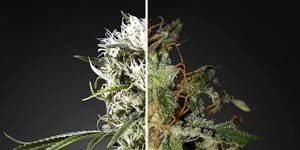
Sativa cannabis makes you high, while Indica makes you stoned. At least, that is what people have been saying for a long time. In reality, there is little evidence that all Sativa strains make you consistently high, while all Indicas are simply suitable for an evening of chilling out like a true couch-potato.This article explains that it is not at all that simple. Just look at the name because it’s wrong.
Sativa is actually Indica
It was Carl Linnaeus who, in 1753, published the scientific name of Cannabis Sativa for the first time. Strangely enough, the term "Sativa" describes the common hemp plant that has been used and grown for so long because of its long, strong fibers and healthy seeds. Sativa literally means: cultivated. Sativa cannabis does not actually exist. Sativa is THC-free fiber hemp.
The most recent and extensive research (Karl Hillig, 2004, 2005) into the origin of different types of cannabis shows that Cannabis Indica has a much greater genetic diversity than Cannabis Sativa. All cannabis actually finds its origins in Indica species, but from different varieties. What we nowadays call Sativa cannabis, is actually Cannabis Indica Indica, and Indica cannabis comes from the Cannabis Indica Afghanica.
People's talk
Every coffee shop and every seed producer still sells Sativa and Indica cannabis. However much we’d like the critter to be called by the right name, we will also give you what you ask for: sativa and indica cannabis seeds. We would like to show you the differences and the similarities. Because they certainly do exist. Just have a look at the appearance of the two cannabis plants.
Recognising Sativa and Indica
The appearance of a cannabis plant tells the grower a lot but it doesn’t have that much to do with the effects of the weed. What’s important to know is that a sativa can ‘disguise’ itself as an indica, and vice versa. This all has to do with the way in which plants were cross-fertilized with each other in the past. We call the plant’s appearance its phenotype. One actual difference is that the two sisters grow differently.Thus, sativa is the taller plant of the two and has a longer flowering period, whereas indica often gives a bigger yield.
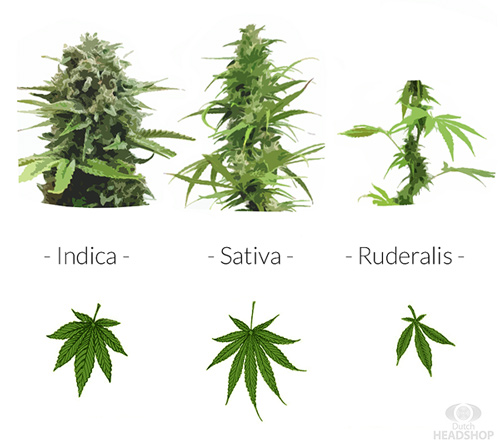
Sativa cannabis plants: Huge, fine-leaved mind expanders
What is the physical difference between plants from our cannabis seeds? Sativas are usually larger than Indicas. A Sativa weed plant also has a finer leaf. A Sativa dominant plant can be recognized by its decorative, thin fingers with 'sharp nails'. An Indica leaf can be as wide as that of a maple.
A Sativa can grow into a huge shrub, of up to three meters high. As a result, the total yield per plant is high. The flowering period is also longer compared to those of Indicas. Sativa dominant crossings are particularly suitable for outdoor cultivation.
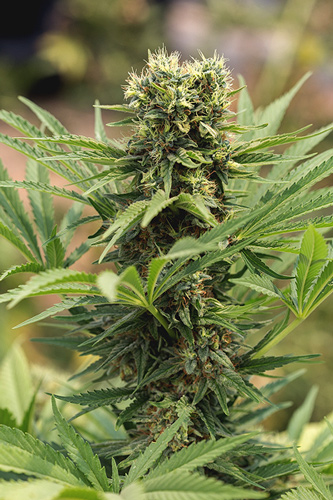
Narrow leaves and an open structure. So it must be a sativa. But look out: it could be a ‘disguised’ indica!
Indica cannabis plants: Compact, Broadleaf Christmas Trees
Indicas remain smaller than Sativas. Another characteristic physical property of the Indica plants is its broad weed leaf. Sativas usually have long and thin fingers, but an Indica leaf looks a bit like a maple leaf. An Indica plant also remains compact in size. This means you can reach higher yields per surface area. The flowering time of a pure Indica is significantly shorter than with Sativas. With a flower time of 6-8 weeks, the Indica is perfectly suited for a short summer season or indoor growing.
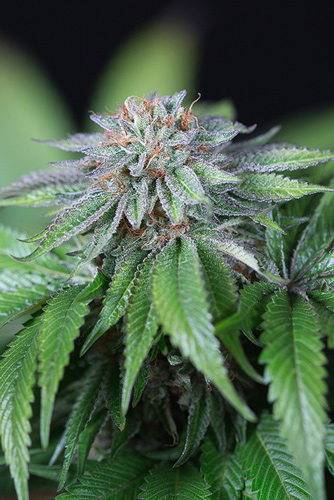
One way of recognising indicas is by the broader leaves. Note - the appearance (phenotype) of a cannabis plant can be different from what the genetics might lead you to expect.
Ruderalis Weed Plants: Automatically in Flower
Next to indica and sativa in the picture above you there is yet another one which not everybody recognises. That is the ruderalis. As you can see, and in contrast to the other two, it is a pathetically small plant. That’s because by nature the ruderalis comes from a completely different region than indica and sativa. Namely the Urals which are located a good deal further north. Due to the limited high season the ruderalis has evolved differently from its big sisters. It has the characteristic that despite the changing light it always comes into flower at the same time of the year. As the result of cross-fertilization of these three different types, it is a characteristic which is now found in sativa and indica. These cannabis plants are called autoflowers (they come into bloom on their own).
Autoflowers
The cross-fertilization of the ruderalis type with both indica and sativa was only successfully done later. Initially the yield was much lower with the autoflowering types but now we are seeing autoflowers with substantial yields appearing on the market. Nonetheless, autoflowers are still small. That makes them ideal for putting in low growing cabinets and the garden. That’s useful if you prefer not to have your plant spotted by the neighbours or local police over the fence.
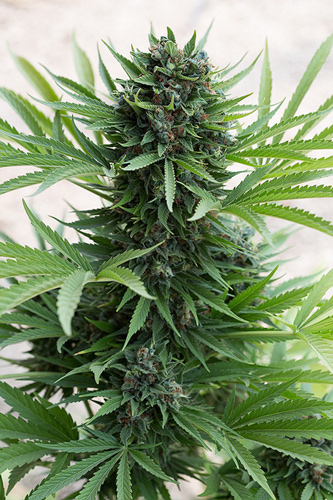
The cross-fertilization of ruderalis and sativa for example provides vigorous, low-growing plants which bloom on their own. We call that autoflowering.
A Short History of Cannabis
A brief excursion into the history will clarify where the supposed effects come from.
Cannabis Sativa
Cannabis Sativa is the first known cannabis plant. In contrast to the Indica varieties, Sativa was not hidden in the mountains, but has simply always grown in places with a lot of sun, as is the case in sunny parts of Europe. It was not only the fibers that were used often. For example, the Chinese already used cannabis as a medicine well before Christ, and also hashish was a well-known stimulant in the Arab world in the ninth century.
Indica - Cannabis from the East
Indica weed only arrived in the Netherlands comparatively recently. The origin, effects and also the growth and flowering are slightly different from pure sativa weed.
Virtually all pure Indica genetics can be traced back to the Himalayas and the Karakorum territory in Asia. The origin of Indica cannabis plants are the north of India, Afghanistan, Pakistan and a mountainous area known as the Hindu Kush (Hindu Kush).
Cannabis Indica was first identified and described by the French naturalist Jean-Baptiste Lamarck in 1785. It took until the 60s and 70s though, before Indica was introduced in the West. In particular, traveling hippies spoke to locals about growing cannabis. They took Indica seeds from this region back to their own Western country.
Due to the sheer scale of the Himalayan mountain range, the areas where indica comes from are extremely remote. As such, it was difficult pollen from one cannabis plant reached another kind of plant. Pure Indica strains were therefore easily kept pure, and genetics may greatly vary from strain to strain.
In the 1960s, the Indica strains brought home were first crossed with the already known Sativa strains. First, Indica genetics were used to improve the Sativa's suitability for indoor cultivation, to keep the plant small and shorten the flowering time.
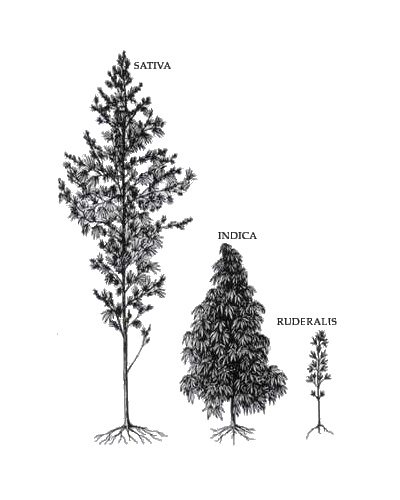
Effects - You get High from Sativa, you get Stoned from Indica
Today, about 700 different strains of weed have been classified. However, several thousands different strains (types of weed, cultivars) will actually be in existence. Some of them forgotten classics, other undiscovered top performers.

You notice the high chiefly in the head. Often it makes you more sociable, more creative and lively.
What is High and what is Stoned?
The difference between high and stoned is mainly in how you experience the weed. Stoned is that effect which you feel chiefly in your body, whereas ‘high’ plays out in your head. Being heavily stoned can result in so-called couch-lock in which you become, as it were, rooted to the spot. Getting up is simply not an option then. You could, but you just don’t want to. On the other hand, if you get really high, then it feels like a buzz in your head. So you feel more in party mode with a good high than when you’re utterly stoned. But they both have their place.
You might imagine that the enormous variety of types has led to a diversity of effects. As well as the familiar THC and CBD, there are some seventy other cannabinoids to be found in both indica and sativa weed plants. That’s without mentioning the more than 120 different terpenes present in weed. These are substances which influence the taste, aroma and also the effect of weed. Sativas are known for the complex composition of their terpenes. We call that a terpene profile. There are an increasing number of websites where you can view extensive analyses of weed together with terpene profiles. So you can see exactly what they contain.
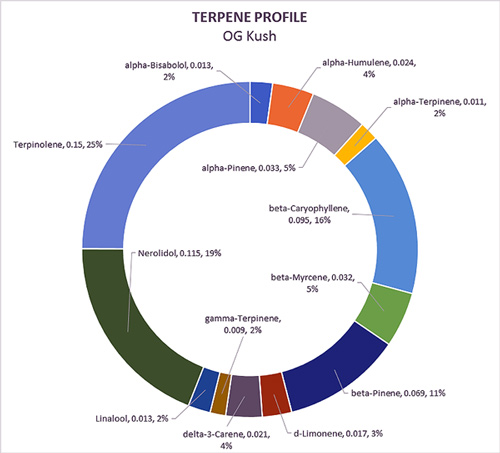
A terpene profile will show you which terpenes are present. Research into how these natural fragrances and flavours interact with THC and CBD, among others, is still in its infancy.
Thus, THC and CBD are not the only active constituents in cannabis. The terpene β-myrcene is suspected to be partly responsible for the couch-lock effect (rooted to the spot because you are completely stoned). And actually most indica strains are now reasonably rich in myrcene. That’s partly why they say that you get stoned from indica.

Do you feel as though you’re rooted to the spot? That’s called couch-lock. A well-known phenomenon when you’re properly stoned.
Sativa for the Head, Indica for the Body
Sativa cannabis seeds are known for their mind-expanding effects, although Sativa cannabis seeds are difficult to describe as a single group. Some strains have a more social effect, while others allows you to better enjoy colors and sound. The CBD percentage is often slightly higher than the Indica-dominant strains. Indica cannabis seeds are renowned for their physically relaxing effects. The THC percentage is often higher than in the sativa-dominant strains.
The Effects of Sativa in a Nutshell:
- Can work socially or creatively or even give you a laughing fit.
- Highly suitable for relaxing medicinal applications at higher CBD percentages.
- You feel excited and lively.
- You feel Sativa more in your head (high or cerebral).
- Better during the day than in the evenings.
- Gives you energy and zip.
The Effects of Indica in a Nutshell:
- Pleasantly relaxed.
- Suitable for medicinal applications for pain at higher THC percentages.
- Takes away stress.
- Often applied before going to sleep.
- Get enough food in for the munchies!
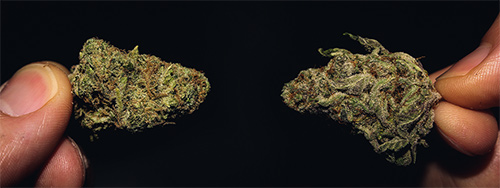
Indica buds are often more compact than sativa buds. Compare the indica-dominant kush (left) and sativa-dominant haze (right). See how hard it is to identify the differences. The drying process and the quality of the bud probably have more influence on the appearance than the genetics.
When comparing Indica cannabis seeds effects with its Sativa counterparts, one can conclude it is wise to look at the composition, or at least at the genetics of its ancestors.Weed in the coffee shop is often neither pure indica or sativa. More often you get hybrids with differing proportions of indica, sativa and ruderalis. Yet they are often cultivated to give you a particular effect. The genetics and above all the chemical composition of each type of weed is what determines its effect. We should not underestimate the so-called entourage effect of all the constituents. The total composition of your favourite weed determines what the effect is.
To make things easier for you, we have researched those effects and growth characteristics at the Dutch-Headshop. For every cannabis seed, we tell you everything we know about the plant. This helps you to make an informed decision about which seed best fits your needs.